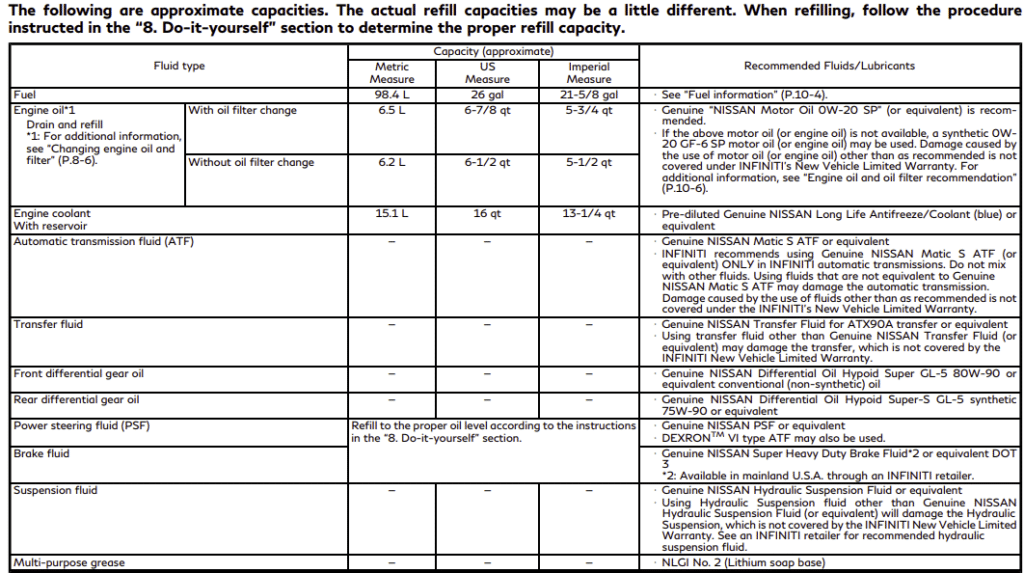The Infiniti QX80 is a luxury SUV, known for its superior comfort, spacious interior, and powerful V8 engine. First introduced in 2014, the QX80 stands out in the Infiniti line-up as a full-sized SUV that seamlessly blends performance with luxury. Over the years, the QX80 has seen several facelifts, with the latest one occurring in 2018.
Throughout these changes, Infiniti has remained committed to delivering an SUV that offers a commanding presence on the road, a refined driving experience, and unparalleled comfort for all passengers.
Transmission fluid is a vital component in maintaining your vehicle’s performance. It serves multiple functions, such as lubricating moving parts, acting as a coolant, preventing rust and corrosion, and transmitting power from the engine to the transmission. The right type and quantity of transmission fluid ensure smooth gear changes, optimizes fuel economy, and ultimately, extends the lifespan of the transmission.
Given its significant role, maintaining the transmission fluid in your QX80 is of utmost importance. Whether it’s knowing the correct type of fluid to use, the recommended change intervals, or understanding the associated costs, keeping up with your transmission fluid can greatly impact the performance and longevity of your vehicle.
Infiniti QX80 Generations and Transmission Types
First Generation (Z62; 2014)
The first generation of the Infiniti QX80 debuted in 2014, featuring a robust 5.6L V8 engine and a 7-speed automatic transmission. This transmission was specifically designed to balance performance with fuel efficiency, providing a smooth and comfortable ride that was consistent with the QX80’s status as a luxury SUV.
First Generation Facelift (Z62; 2015-2017)
Infiniti introduced the first facelift of the QX80 in 2015, carrying through to 2017. Despite several aesthetic and feature upgrades, the core performance components, including the 7-speed automatic transmission, remained unchanged. This generation continued to use the same transmission fluid and capacity as the original 2014 model.
Second Facelift of First Generation (Z62; 2018-Present)
In 2018, Infiniti launched the second facelift of the first-generation QX80. While the visual enhancements were significant, the underlying powertrain including the 7-speed automatic transmission remained the same. Despite the improvements in technology, comfort, and style, the transmission fluid specifications and maintenance requirements remained consistent with the earlier models.
It’s worth noting that while the transmission type remained consistent across these models, ensuring the correct fluid type and maintaining regular fluid changes is crucial to preserving the performance and longevity of your QX80’s transmission.
2014-Present Infiniti QX80 Transmission Fluid Capacity And Transmission Fluid Type
For the Infiniti QX80, across all its iterations, Infiniti has recommended the use of Nissan Matic-S automatic transmission fluid. This fluid has been specially formulated for use in Nissan and Infiniti vehicles to promote optimum performance and longevity of the transmission system. The Nissan Matic-S fluid replaces the older Nissan Matic-J fluid, but it’s fully backward compatible with vehicles that originally used the Matic-J.
- The exact Original Equipment Manufacturer fluid that your vehicle came with; use where Nissan Matic-S fluids are required in Nissan, Infiniti, and other make vehicles
- Matic-S ATF supersedes Matic-J ATF
- For “Rear Wheel Drive” 5-speed automatic transmissions (that is 350Z, Armada, Titan, G35, FX35, FX45, M45, Q45)
- Not for Nissan 3 or 4-speed automatic, front wheel drive 5-speed automatic or CVT transmissions
While the manufacturer’s recommendation should generally be followed for the best performance and longevity, there are occasions when you may need or choose to use a compatible alternative. Several high-quality synthetic transmission fluids on the market meet or exceed the performance specifications of the Nissan Matic-S fluid. These include the Idemitsu ATF Type S, Valvoline MaxLife ATF, Royal Purple 01320 Max ATF High Performance, and Castrol Transmax ATF/CVT Universal.

These alternatives are suitable for use in a wide variety of vehicles and are formulated to provide excellent performance across a wide range of operating conditions. They can provide superior protection against wear, better resistance to oxidation and thermal breakdown, and improved performance in extreme temperatures.
First Generation (Z62; 2014)

The initial 2014 Infiniti QX80 came with a 7-speed automatic transmission. The transmission fluid capacity for this model is approximately 10.6 quarts (10 liters) for a total refill.
However, during a typical fluid change where the fluid is drained and then refilled, you’re likely to replace around 5-6 quarts, as some fluid remains in the transmission and its components.
First Generation Facelift (Z62; 2015-2017)

The first facelift of the Infiniti QX80 from 2015 to 2017 maintained the same 7-speed automatic transmission and therefore, the transmission fluid capacity remained unchanged.
As with the 2014 model, a total refill would require approximately 10.6 quarts, with regular change intervals seeing a replacement of around 5-6 quarts.
Second Facelift of First Generation (Z62; 2018-Present)
The second facelift of the QX80, from 2018 to the present, kept the same transmission and, consequently, the transmission fluid capacity is still about 10.6 quarts for a total refill. During regular change intervals, you would typically replace about 5-6 quarts of the transmission fluid.

Always consult your vehicle’s manual or a trusted mechanic to confirm the accurate fluid levels for your particular vehicle.
Infiniti QX80 Optimal Change Intervals
For the Infiniti QX80, the manufacturer recommends a transmission fluid change interval of approximately 60,000 miles under normal driving conditions. This recommendation serves as a general guideline, but the actual interval can vary based on several factors including your vehicle’s specific usage conditions and the type of transmission fluid used.
Factors Affecting Change Intervals
Several factors can affect the optimal transmission fluid change interval:
- Driving Conditions: Severe driving conditions such as frequent stop-and-go traffic, towing heavy loads, off-roading, or driving in extremely hot or cold climates can accelerate the breakdown of transmission fluid and may require more frequent changes.
- Type of Transmission Fluid: Higher-quality synthetic transmission fluids often offer longer service intervals compared to conventional fluids due to their superior resistance to thermal breakdown and oxidation.
- Vehicle Usage: If the vehicle is not used frequently, or only used for short trips, the transmission fluid may require changing more often. This is because the fluid does not get hot enough to burn off moisture and impurities, which can accelerate the degradation of the fluid.
Always remember that the transmission fluid change interval should be seen as a guideline, not a hard rule. Regularly checking the condition of your transmission fluid can help determine when it needs to be replaced. If the fluid is dark, dirty, or has a burnt smell, it’s likely time for a change. As always, when in doubt, consult a trusted mechanic.
Infiniti QX80 Transmission Fluid Change Cost
The cost of a transmission fluid change for an Infiniti QX80 can vary based on your location and the specific service provider. However, on average, you can expect to pay between $200 and $300 for a professional transmission fluid change. This cost includes the new fluid and the labor required to drain the old fluid, replace it with new fluid, and dispose of the old fluid in accordance with environmental regulations.
Factors Influencing the Cost
Several factors can influence the cost of a transmission fluid change:
- Labor Rates: The hourly rate charged by the mechanic or service center can significantly affect the cost. Labor rates can vary widely depending on the region and the reputation of the service center.
- Fluid Cost: The type of transmission fluid used can also influence the cost. High-quality synthetic fluids typically cost more than conventional fluids, but they can provide better performance and potentially longer service intervals.
- Additional Services: If other services are performed at the same time, such as replacing the transmission filter or performing a transmission flush, the cost can increase.
Remember, while it may be tempting to opt for the cheapest service, it’s essential to choose a reputable service provider to ensure that the job is done correctly and that high-quality fluids are used.
Last update on 2025-12-22 / Affiliate links / Images from Amazon Product Advertising API
















